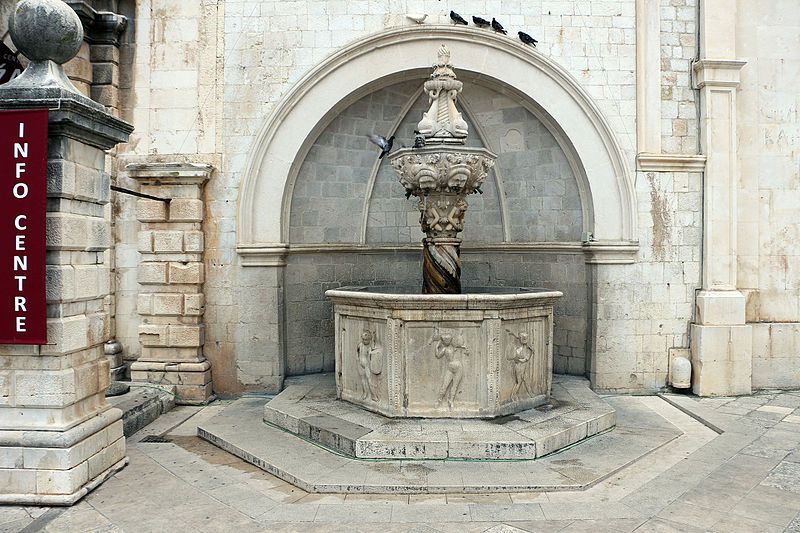Dubrovnik UNESCO World Heritage Management Plan: First in Croatia
August 20, 2021 - The Dubrovnik UNESCO World Heritage Management Plan is the first management plan for the world heritage in Dubrovnik and the first of its kind in Croatia.
The City of Dubrovnik has obtained the Ministry of Culture and Media's consent to entrust the implementation of the Management Plan of Dubrovnik's Historical Entity to the Institute for Dubrovnik's Reconstruction. This fulfills one of the legal steps that precede the appointment of the ZOD as the main coordinator of the plan's implementation, which is envisaged in the activities listed in the Plan's text, reports HRTurizam.
Following this decision, the Dubrovnik mayor, Mato Franković, was presented with a Proposal to conclude the "Dubrovnik Old Town" UNESCO World Heritage Management Plan to the Public Institution Institute for Dubrovnik's Reconstruction. According to the City of Dubrovnik, the conclusion will be on the schedule of the next City Council session.
Namely, the Institute for Dubrovnik's Reconstruction successfully drafted the plan, which the City Council unanimously adopted in the previous convocation. Furthermore, the appointment of the ZOD as a legal entity at the head of its implementation will establish a continuous management system that will ensure that all challenges are addressed, which are defined in the Action Plan through the priority levels of implementation to preserve the outstanding universal value of the heritage.
The "Dubrovnik Old Town" UNESCO World Heritage Management Plan is the first management plan for the world heritage in Dubrovnik and the first of its kind in the Republic of Croatia. Although drafting the Management Plan arose from the instructions of the UNESCO-ICOMOS World Heritage Committee and Reactive Mission 2015, drafting the document itself began in July 2019. It was based on an extensive participatory process, which defined goals and priorities. As a result, an action plan has been developed to implement strategic activities, together with monitoring indicators to measure the implementation of objectives and activities.
"Dubrovnik Old Town" UNESCO World Heritage Management Plan

The purpose of the World Heritage Management Plan is to provide a long-term management system that will preserve the quality, originality, and integrity of the recognized world heritage and components that confirm outstanding universal values while maintaining the quality of life and active multifunctional use of the city center.
The management plan covers the entire heritage area, its contact zone, and the associated environment.
The strategic activities of the Management Plan are asset management and capacity building; protection, preservation, and maintenance; sustainable development; tourism management; and traffic management.
You can read the entire management plan here.
For more, follow our lifestyle section.
VIDEOS: Amazing New Google Project Shows Croatian Culture to the World
September 18, 2020 - Incredible new video series explore Croatian culture, its natural assets, and the country's rich traditions, a collaboration with Google
Steeped in history and tradition, Croatian culture is incredibly diverse. Recognised as being of high value to the country's appeal and its understanding of itself, many items from this rich heritage appear on the protected UNESCO list.
The Croatian National Tourist Board has teamed up with Google Arts & Culture and partners The Museum of Arts and the Museum of the Sinjska alka to produce an incredible series of videos that explore this cultural heritage.
From arts & crafts to music and dance, natural assets and architecture, the new videos show off the rich menu of traditions assets that make Croatia such an incredible country. With so many items included on the protected UNESCO list, there's always something more you can learn about Croatia, no matter how many times you visit.
Lace-making, costumes of folklore, ancient instruments, time-honoured recipes, beloved festivities and distinct, regional styles of music are just some of the facets of Croatian culture explored in the videos. Now, people from all over the world can explore Croatian culture and heritage before they even arrive. The menu of videos and accompanying media is presented in both English and Croatian.
Some of the videos in the series are not new, but they have been selected by the Croatian National Tourist Board for inclusion as they are the best at showcasing their particular aspect of Croatian culture. Alongside the video presentations, there are a wealth of photographs and informative texts. You can view the whole new collaboration with Google Arts & Culture here
For the latest travel info, bookmark our main travel info article, which is updated daily.
Read the Croatian Travel Update in your language - now available in 24 languages
Croatia Marks 40 Years Since Addition of Dubrovnik, Split and Plitvice to World Heritage List
ZAGREB, October 26, 2019 - Croatia's Ministry of Culture on Friday recalled that 40 years ago, UNESCO added the first three Croatian sites to its list of World Heritage sites: Diocletian’s Palace in Split, Dubrovnik's Old Town and the Plitvice Lakes, the oldest and the most visited national park in the country.
Since then, seven more Croatian sites have listed as World Heritage sites: St James Cathedral built in the Adriatic town of Šibenik in the 16th century, the old town of Trogir near Split, the Episcopal Complex of the Euphrasian Basilica in the Istrian town of Poreč, and the Stari Grad Plain on the Dalmatian island of Hvar.
Among those seven sites there are three multinational nominations: the medieval tombstones and graveyards called "Stečci", scattered in Croatia, Bosnia and Herzegovina and some parts of Montenegro and Serbia; the defensive system of Zadar and St Nicholas Fortress in Šibenik, that is six defensive walls built by the Republic of Venice between 15th and 17th century along the Adriatic coast, and this kind of fortifications can be found in Italy and Montenegro.
Croatia is also part of the Primeval Beech Forests of the Carpathians and Other Regions of Europe. Primeval Beech Forests of the Carpathians is the largest UNESCO World Heritage site in Europe, extending across 12 countries. The Croatian part of the Carpathians make the Paklenica and Northern Velebit national parks.
Croatia boasts a particularly rich intangible heritage, and 17 examples of this heritage are on the UNESCO list of intangible heritage.
Some of the most famous entries are lacemaking in Croatia, the Sinjska Alka knights' tournament in Sinj, and Klapa music, a form of traditional a cappella singing in Dalmatia.
More news about UNESCO heritage can be found in the Lifestyle section.
Lipik Farm to Propose Inclusion of Lipizzan Horses on UNESCO Heritage List
ZAGREB, October 13, 2019 - The 12th anniversary since the return of 68 Lipizzan horses, who were seized and taken to Serbia at the start of the war in 1991, was marked at the Lipik horse farm in eastern Croatia, and a proposal was put forward that the Lipizzan horses be protected as the intangible cultural heritage of humanity.
A working meeting was held in Lipik, involving officials from the culture ministries of Austria, Slovenia, Bosnia and Herzegovina, Hungary, Slovakia, Romania, Italy and Croatia. A representative of Serbia attended as a guest.
The director of the Lipik horse farm, Damir Jakšić, said that the participants in the meeting had prepared a draft application that would be submitted to UNESCO in March 2020 requesting that the Lipizzan horses be protected as the intangible cultural heritage of humanity.
Horse-breeding has been consolidated and now the farm has 87 studs and mares which will be evaluated this autumn, Jakšić said, adding that 5,200 visitors had visited the farm last year and 6,200 so far this year. He said that a building permit had been secured and money was being raised to build a new farm.
More UNESCO heritage news can be found in the Lifestyle section.
Renovated St. Nicholas' Fortress in Šibenik Opens Its Doors to Visitors
ZAGREB, June 16, 2019 - St. Nicholas' Fortress, which is on the UNESCO World Heritage List, formally opened its doors to visitors after two-year-long renovation. In the last three years, about five million kuna (675,000 euro) was spent on the revamping this fortress, and 4 million was set aside by the Šibenik-Knin County while the rest was provided by the Culture Ministry.
The project of revitalisation of the site encompassed the thorough cleaning and reconstruction of some segments of the fortress to improve the safety conditions for visitors.
Attending the ceremony, Culture Minister Nina Obuljen Koržinek thanked all who participated in the project. She emphasised the importance of the fortress as part of the national heritage.
Šibenik is the fifth city in the world to have two landmarks added to the UN World Heritage List -- the St. James' Cathedral and this fortress, she recalled.
In July 2017, Šibenik's St. Nicholas Fortress and Zadar’s fortified city walls and gates were officially inscribed on UNESCO's protected world heritage list at the 41st meeting of the UNESCO World Heritage Committee in Krakow.
The two coastal sites were inscribed as part of protected defence systems on the territory of the former Republic of Venice. Šibenik's St. Nicholas Fortress, one of the strongest fortifications on the Adriatic, and Zadar’s 3-km-long fortified city walls and gates were built in the 16th century by the then Republic of Venice as defence from invading Turks.
Šibenik's cathedral, which was built in the 15th century, won its global recognition in 2000, when it was entered in the UNESCO World Heritage List. it is often known as "St Jacob's", because Croatian, like many other languages, uses the same name for both "James" and "Jacob". It is dedicated to Saint James the Greater.
More Šibenik news can be found in the Lifestyle section.
UNESCO World Heritage – Episcopal Complex of the Euphrasian Basilica in the Historic Centre of Poreč
This article will take a look at the Euphrasian Basilica in beautiful Poreč, which is listed on the prestigious UNESCO World Heritage List.
This basilica is extraordinary because it is a truly unique example of early Christian and Byzantine architecture and boasts some spectacular mosaics from that time. This is a complete surviving complex of this type, and this episcopal complex consists of the basilica, the atrium, the baptistery and the episcopal palace, which is an impressive example of religious architecture.
Poreč has a very long history and was initially the Roman town of Paretinum. The Euphrasian basilica is from the 6th century, and it remains one of the landmarks that makes Poreč recognisable to the world. It’s been on the UNESCO World Heritage List since back in 1997 based on its level of preservation and sheer beauty.
.jpg)
The history of Christianity in Poreč dates back to the 1st century after Christ (AD). At the end of the 2nd century, there was a Christian community under the bishop Mauro – they gathered secretly in his house which actually became the first church in the town. There lay a decorative fish mosaic which was an early Christian symbol.
.jpg)
The first bishop and clergy in Poreč all suffered martyrdom in the middle of the 3rd century, while in the year 313, the Christians were granted the freedom to worship in the Roman Empire. The former secret gathering place then became the very first public church.
At the same location, the first basilica was built during the second half of the 4th century, and that remains that of bishop Mauro and the other martyrs who moved to the early Christian cemetery. A larger basilica was constructed in the first half of the 5th century next to the existing basilica, and it was known as the Pre-Euphrasian basilica.
The floor mosaic of the temple area of the Pre-Euphrasian basilica was placed in the former sacristy. When Euphrasius first came to Poreč, he almost destroyed the old basilica in the mid-6th century, and built a magnificent three-nave basilica which still stands in Poreč today. At that time (543-554), the entire complex was made – the atrium, the bishops palace and the old baptistery.
The influence of Constantinople, the very centre of early Byzantine culture, is visible in the art and mosaics used in the construction and the decoration of the basilica. The floor of the basilica was covered with mosaics, and there were two layers of floor mosaics – the lower level belongs to the basilica from the fifth century, while the upper level is from the Euphrasian basilica of the sixth century.
.jpg)
The mosaics which decorated the interior are a valuable piece of heritage from the Byzantine era's art, and thanks to the floor mosaic and its preserved inscriptions, we can witness all the periods of its building and restoration even in the modern day. The basilica was built on an already existing Roman heritage site, meaning that various Roman artefacts can be found there, too.
The first church had three parallel rooms, and the central one was used as a basilica and even then, it enjoyed the status of a cathedral. In the 5th century, there were two basilicas in the south which were placed in front of the current Euphrasian basilica, while in the north, the walls and columns were kept standing. There was also a baptistery which remained in use, followed by another which came later on.
To understand why the Euphrasisus wanted to build such a spectacular basilica, it is essential to understand the fact that in the 6th century, Poreč was a small town in the then dying Roman Empire, and the emperor Justinian wanted to restore the Roman Empire's old glory. This is the time in which bishop Euphrasius started to build on the location of the ancient basilica and make this one of the biggest episcopal complexes of that time.
Shiny ''new'' Byzantine art created a unique piece of heritage on the Roman foundation. When Euphrasius came to Poreč, he found a town boasting a very long history, and he became the head of the well established Christian community which already had a few martyrs like St Mauro and St Eleturis under its belt by then.
Euphrasius began construction on the foundation of the previous church where he found early Christian mosaics decorated with images of fish with the mosaic donators' names inscribed on them, which helped in tracing the early Christian community in Poreč. There is one stone panel with an instruction written on it, from which we've been able to learn about the transfer of the body of St Mauro from a cemetery outside the town, to the place where the very first church originally once stood.
.jpg)
The new basilica, which was large in size, grew along with existing church objects. The construction of the basilica, the organisation of interior spaces, elements and ornaments, images on mosaics were all representing essential steps in the development of western art, influenced heavily by art from the east.
The entrance was formed one street before, and opposite the entrance, lies the baptistery – eight angles are from Pre-Euphrasian times, and the base is antiquity-era architecture. The structure of the wall and the wooden constructions of the roof are the work of local builders.
.jpg)
On the north-east angle of the basilica, there is a memorial chapel in which the layout is a bit different. The chapel, which was home to the relics of martyrs, has an oval atrium in front. The whole building underwent much needed restoration work in the 19th century.
The previous buildings on the site were construction material for the atrium, baptistery, and some parts of the basilica's walls. The organisational structure of the complex is confirmation of the whole concept which bishop Euphrasius initially had in mind, and this highlights just revolutionary his ideas really were for that time period. The rich decorations of the interior are additional evidence of the advanced ideas Euphrasius had, and represented Byzantine influence.
In front of the entrance to the basilica lies an atrium formed in the shape of a square, while the middle part of the atrium is an open space surrounded by arches - three arches on each side to be more specific. The eastern side of the atrium leads to the basilica and the western side to the baptistery. The central arch of these sides is elevated.
.jpg)
The arched-on columns and capitals were brought from Constantinople, just like with the one from the basilica. In the 16th and 17th centuries, during the great plague, the atrium and area around the church were used as a cemetery, with the atrium being rebuilt in the second half of the 19th century. Fragments of stone monuments from different periods of the Episcopal complex are displayed on its walls.
The baptistery is located in the western part of the Episcopal complex with the entrance facing the basilica. It was built in the 5th century and bishop Euphrasius had it restored and decorated in the 6th century. It was largely reconstructed in 1881 and then once again after the turn of the century, in 1935. The baptistery is an octagonal building with a hexagonal baptismal pool in the middle. It was surrounded with a sixteen-sided ambulatory, a sloping roof and three entrances.
The bell tower next to the Euphrasian basilica was built on the western side of the baptistery in 1522. Its 35 metres in height and provides a stunning view of the area. The bishops place is an integral part of the Episcopal complex, it is located in the northwestern part of the complex. On the first floor, there is a large ceremonial hall with a semi-circular apse on the northern side, it once used to be the audience hall, where the bishop received guests. Rights next to it on the left and the right sides there were once small chapels.
.jpg)
On the porch in front of the bishop’s palace lie some stone exhibits, capitals and various fragments of inscriptions in stone from previous basilicas in the area. The most important part of this lapidary is placed on the ground floor of the bishop’s palace. On the premises of the bishop’s palace, visitors can see different objects used by the church which span entire centuries.
The later built ciborium is part of the basilica from the 13th century, it presents as a masterpiece created seven centuries after Euphrasius' initial work. In 1277, a large marble ciborium was made, and its canopy was set on four columns which were taken from the original ciborium. The new canopy was covered with mosaics and displayed an image of the Annunciation. From this time, visitors are able to see visible differences in the composition and design when it comes to iconography and images of the Virgin Mary and the angels.
In the 13th century, the process of cultivating various pieces of cultural heritage one after the other took place once again – older pieces of heritage was blended into newer pieces. Early Byzantine capitals and columns hold the construction of the new gothic canopy covered with mosaics which clearly mark the end of one era and the beginning of a new one, a process which slowly removed the characteristics of Byzantine art and shows the turn towards the Venetian influence.
The Venetian influence can be seen at the basilica by turning to western cultural influence - this is noticeable in all the future interventions and additional work on the basilica and in Poreč.
.jpg)
The naves of the basilica share two rows of nine arcades and are connected to their pillars on the wall at their western and eastern ends. The arcade consists of gray marble poles that are based on well-shaped bases, and in the upper part, they end with the capitals over which they are imposed on round medals, in which there are embellished Euphrasius monograms.
The basilica and the whole complex have various capitals, rich perforations, and ornaments. There are several marble panels decorated with reliefs with different symbols like crosses, monograms, birds, deer, stylised horns...
.jpg)
In the arcades on the north side, the stucco was also painted in its original form. This visual glitter should also add the incrustations in the lower part of the apse. The pieces of multi-coloured marble and nacre are placed on the walls and make for creative ornaments. In the apse, there are also marble seats for the priests who close the marble slabs with dolphin reliefs on the side, while the centre of the semicircle is the place for the bishop's chair.
The walls of the Euphrasian basilica are one of the most valuable pieces of heritage as they boast various mosaics. Additionally, this is the place where iconographic innovation was applied for the very first time in the West. In the central part of the apse one can see the image of the Virgin Mary, which usually was the place for the image of Christ. The image shows the Virgin Mary sitting on the throne holding baby Jesus, who is wearing festive Roman clothes. On each side sit angels who are leading the groups coming to greet her. On the left side, three unnamed martyrs with wreaths in their hands and halos above their heads approach Mary, they appear like angels dressed in festive Roman clothes.
.jpg)
On the other side, behind the angel, stands St Mauro, depicted in the same way as the previous three martyrs, but with a printed name and a halo. This bishop and the saint of Poreč is leading a group of the contemporary people: the bishop Euphrasius holding the model of his basilica, the archdeacon Claudio (Euphrasius' brother) and the archdeacons son named Euphrasius, as well. Euphrasius had written his desire to renew the old basilica there.
The angels and the holy martyrs of the parade surround the Virgin Mary on the throne. Opposite to them, the living characters without halos are depicted in an individualised manner, as if they were portraits.
.jpg)
Other mosaics depict a strong Christian iconography too. The image of the Virgin Mary is the central point of Euphrasius basilica. She is of course holding baby Jesus, and this image presents two of the unarguably central figures in Christianity. The image of Annunciation in Christian iconography is the connection between Jesus and Mary. The image of Annunciation is based on Luke’s gospel, and such images can be traced as far back as the 4th century in catacombs, while this iconography became more developed in the 5th century, as is visible in the Poreč basilica.
In the 6th century, in the time of Justinian and Byzantine-influenced art, the Virgin Mary wore the veil which symbolised her virginity. The Virgin Mary is pictured sitting on the throne whose columns blend with the basilica's columns, which signifies the connection of the Virgin Mary to the church.
.jpg)
Mary holds a rove while an angel greets her. The angel is turned in a manner where half of its profile can be seen, which was specific for the art of the time, shown as if in movement, wearing bright clothes. Opposite to the image of the Annunciation sits the image of the visit of the Virgin Mary to her cousin Elizabeth. In the middle part of the apse between these two images from the Virgin Mary's life, there is an image of Saint Zachary, an angel, and John the Baptist. In the lower part of the triumphal arch, there are thirteen round medallions.
In the middle section, there is the image of Christ shown as Agnus Dei, while on each side there are six saints pictured, along with their respective names. On the top part of the apse, there is an image of the apostles with Christ in the middle – Christ is presented as a young ruler who rules over the world. The Apostles are surrounding Christ in this image, and have their names written around their halos. In the higher parts of the side apse, there are fragments of mosaics boasting almost identical images – the large figure of Christ comes down from the clouds and is seen placing bay leaves on the heads of two martyrs.
Mosaics of the sort weren’t just placed in the interior of the basilica, but were placed on the outside too. Unfortunately, they weren’t preserved and were covered over when restoration work took place periodically. They originally showcased an image of Christ sitting on the globe, along with his Apostles.
With this extremely rich array of well preserved heritage, the Euphrasian Basilica is somewhere you must visit! Until you manage to pay it a visit, you can check out a virtual tour by clicking here (make sure you have Flash enabled!).
.jpg)
SOURCE(S) (text and photos): Tourist Board Poreč, Istra Culture, UNESCO
UNESCO and Croatia: World Heritage Site – Dubrovnik Old City
Let's take a look into one of the best-known heritage sites in Croatia and the city that attracts millions of visitors each year. This in-depth article about Dubrovnik comes at about the same time as the 40th anniversary of the inscription of Dubrovnik's old city on UNESCO's World Heritage list, and the 10th anniversary of inscribing Festivity of St. Blaise onto UNESCO's List of the Intangible Cultural Heritage of Humanity.
Conveniently enough, we're at the beginning of a very special month for Dubrovnik, for an event which has been happening each year on February the 3rd.
Well known as the ''Pearl of the Adriatic'' or more recently as the popular Game of Thrones filming location (Kings Landing), Dubrovnik has been one of the historically most important Mediterranean ports since the thirteenth century. Dubrovnik has numerous preserved Gothic, Renaissance and Baroque churches, monasteries, palaces, and fountains. It did get damaged during the earthquake in 1667, and more recently during the Homeland War, but it still kept its beauty.
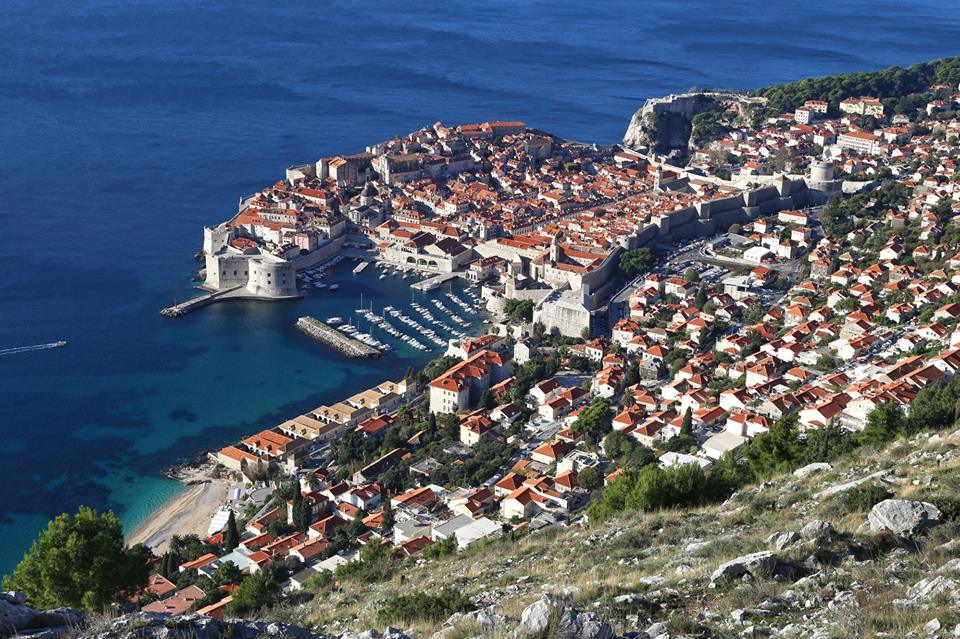
TZ Dubrovnik
To understand just why Dubrovnik has so much heritage and how it has been so well preserved, let’s take a look into this remarkable city's very long history.
The Dubrovnik Republic, which represents the golden period of Dubrovnik's history, perfectly regulated the city and life within it through its statute and other historic documents. This well-preserved city has been able to afford to lie on its Laurels owing to this, as well as its good geographic location and economy which was for centuries based on maritime and merchant activities.
The latest archaeological research discovered that there was a settlement dating back to the sixth century at this location, and this expanded with the arrival of Croats in the seventh century.
Travel and traffic between east and west during and after the Crusades resulted in the development of maritime and merchant centres in the Mediterranean and Adriatic in the twelfth and the thirteenth centuries. Another important event in the history of Dubrovnik was the Zadar Treaty, which in 1358 liberated Dubrovnik from Venetian rule while other Dalmatian towns fell under Venetian rule in 1420 and remained under their control up until the end of 18th century.
This is the reason why Dubrovnik was able to develop much more quickly than the other Dalmatian towns.

TZ Dubrovnik
In the fourteenth and fifteenth centuries, Dubrovnik was one of the most significant maritime and mercantile centres of Adriatic together with Venice and Ancona. Dubrovnik expanded its territory by using contracts and purchasing the land around the town including the islands, such as Mljet, Lastovo, the Elaphites, and of course Lokrum. The independence of the Dubrovnik Republic was completed by the fifteenth century when they had the independent election of the rector and council, and set their own currency, their own state flag with the image of St. Blaise, independent legislature and the right to establish consulates abroad.
The state authority was based on the great council which had members of aristocratic families in it. They appointed the members of the Senate and the small council which was the executive body of the great council. The rector was appointed on a monthly basis as a nominal symbol of authority.
In the fifteenth century, Dubrovnik had a well-organised transit trade route with the Balkan inland. In 1525, due to the Ottoman expansions in the area, the Dubrovnik Republic decided to pay tributes to the Ottomans and in return, they had the right to free trade throughout the growing Ottoman empire. The Dubrovnik Republic had no army on its own but managed to preserve its independence by being neutral in international conflicts and using the tutelage of powerful countries. The only rival of the Dubrovnik Republic was the envious Venetian republic.
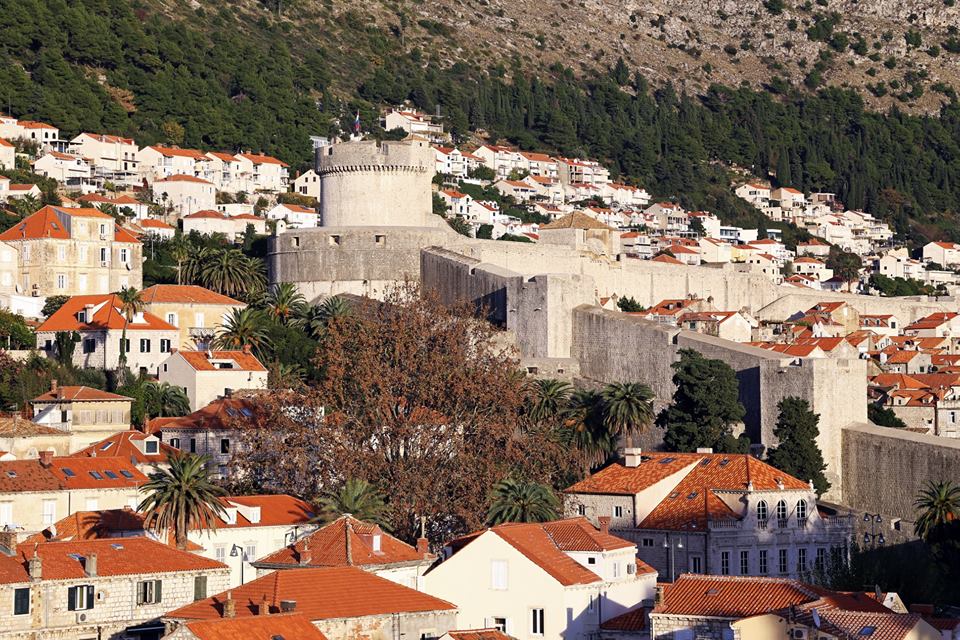
TZ Dubrovnik
The Dubrovnik Republic's golden age started in the sixteenth century – back then, Dubrovnik's merchant navy matched those across the rest of the globe with its quality fleet of 180 to 200 ships. These ships were used for long and dangerous journeys through the Mediterranean and the Black sea, as well as ocean journeys to northern ports in England and Germany, even going as far as India and the Americas. Material prosperity helped to shape a humanist culture and the Republic received a great level of achievement in its urban and architectural development that has been maintained to the present day in its literature and poetry, sciences, and in many other fields of art and culture.
In the seventeenth century, the general crisis of the Mediterranean maritime affair also affected Dubrovnik's maritime trade. The catastrophic earthquake in 1667 was another awful event for the Dubrovnik Republic. In the eighteenth century, Dubrovnik got another chance at the economic revival of maritime trade under a neutral flag. In 1815, Dubrovnik joined other parts of Dalmatia and Croatia. In more recent history, Dubrovnik was damaged during the Homeland War, with the worst attack happening on December the 6th, 1991.
Now, let's see what can be found in Dubrovnik when it comes to valuable heritage which has been recognised by UNESCO and numerous people who visit Dubrovnik each year.
Dubrovnik's City Walls
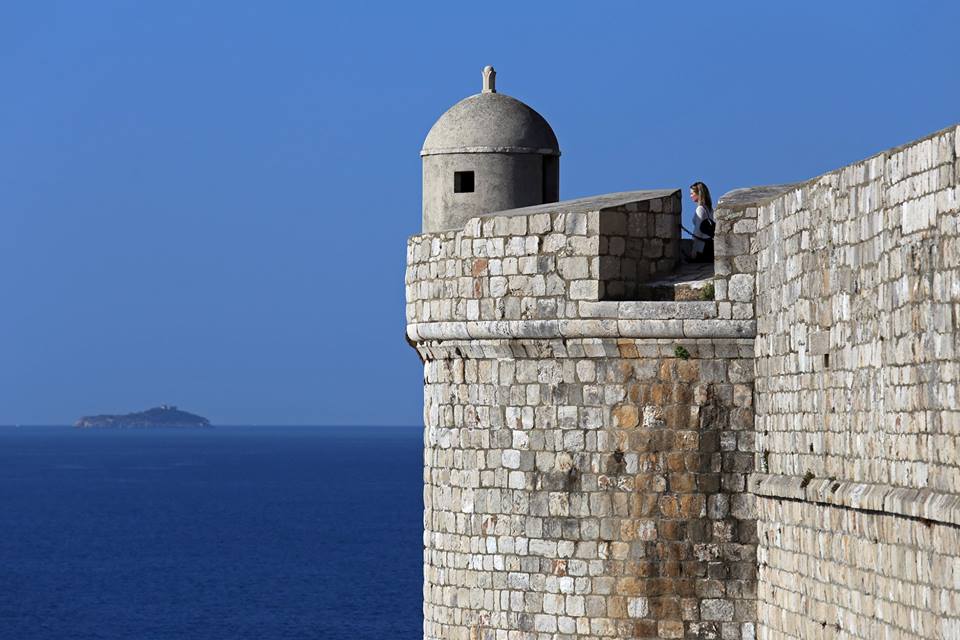
TZ Dubrovnik
Dubrovnik's city walls were established in the thirteenth century and were systematically and continuously perfected over several hundred years, until 1660, when the last tower, the St. Stephen’s Bastion, was finished. The walls stretch for over 1940 metres and consist of the main wall, sixteen towers, three forts, six bastions (bulwarks), two corner forts (cantonatas), three pre-walls with several turrets, three moats, two barbicans, two drawbridges, and one breakwater.
This is one of the best-preserved fortification systems in Europe with three forts: Minčeta, Bokar and St. John. The walls are up to 22 meters high in some places, with a thickness of between 4 to 6 meters from the mainland side, and from 1/5 to 3 metres on the seaside.
Among the many known and unknown builders of the wall and its construction, some of them are: Paskoje Miličević, Nicifor Ranjina, Marin Držić, Župan Bunić, Miho Hranjac, Juraj Dalmatinac, Michelozzo di Bartolomeo Michelozzi of Florence, Onofrio and Simeone Della Cava, Antonio Ferramolino of Bergamo, Giovanni da Siena, Bernardino di Parma, Marcantonio Bettaci of Florence, Seporoso Mateucci of Fermo and Giovanni Baptista Zanchi of Pesaro.
The shape of the walls was definitely defined by available weapons of the time and the various defence techniques of the past. The first walls were built when the first settlement was consctructed back in the eighth century, and Dubrovnik enjoyed the natural protection of the sea, with the walls acting as additional protection for Dubrovnik's citizens.
You can enter Dubrovnik's city walls next to Pile Gate, St. John's Fort and St. Luke's Fort.
Minčeta Fortress
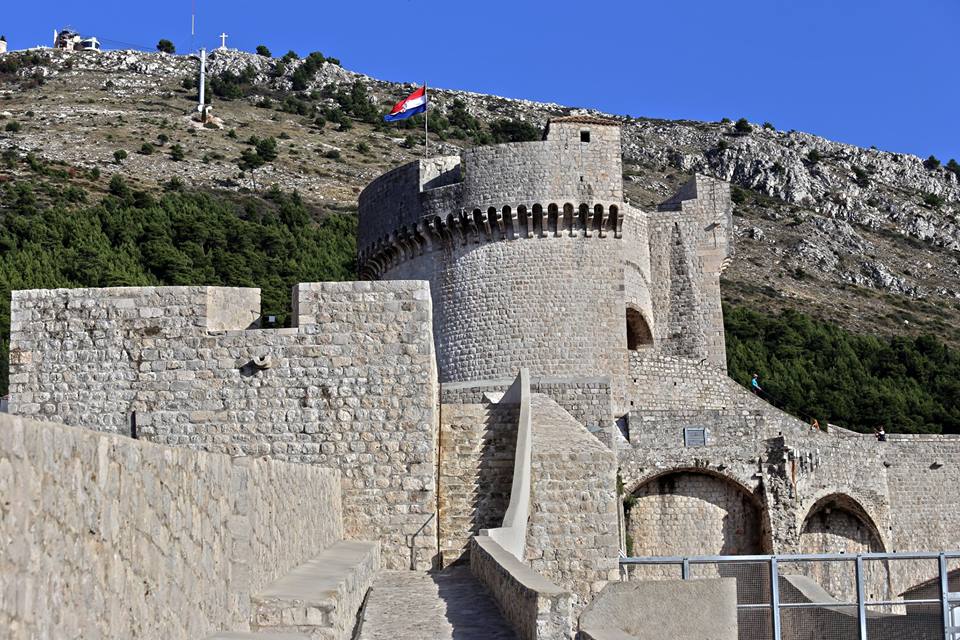
TZ Dubrovnik
Minčeta fortress is placed on the highest north-western part of the city. It is a large circular tower with a big battlement suspended by a stone support. The first quadrangular tower was constructed by Nikifor Ranjina in 1319, the architect Michelozzo Michelozzi gave it its present form and it was completed in 1464 based on the design of Juraj Dalmatinac, who was famous for numerous works in Dalmatia among which the best-known is the Šibenik cathedral, another UNESCO world heritage site.
St Luke’s Tower
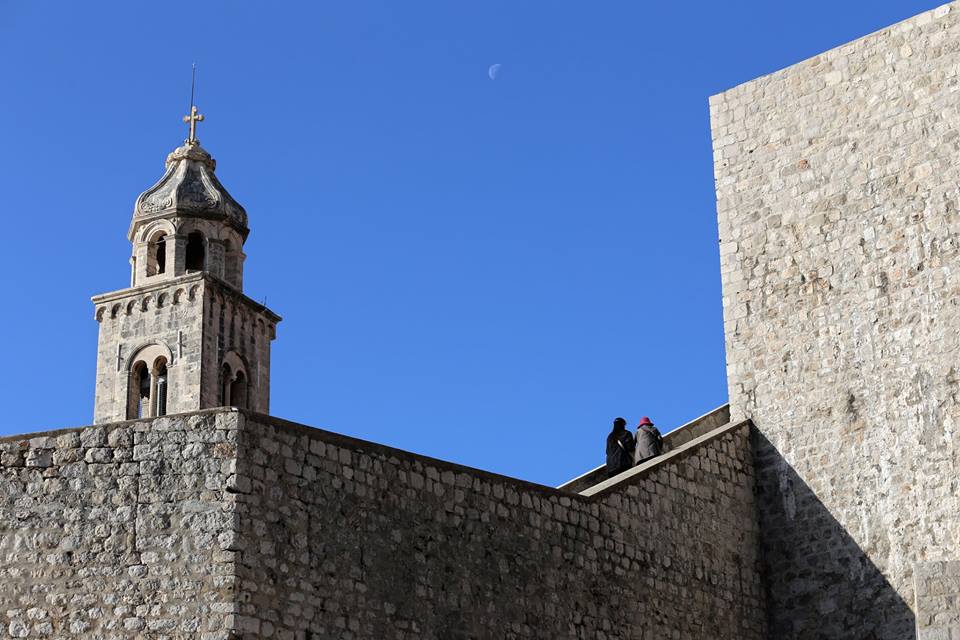
TZ Dubrovnik
If you walk eastward along the city walls towards Ploče gate, you will get to St. Luke’s tower. In 1467. Paskoje Miličević designed the bulwark for the old St. Luke’s tower with openings for cannons. The tower controlled the access to the harbour.
St John's Fort

TZ Dubrovnik
This is the first quadrangular pier tower and it was constructed back in 1346 in order to protect the city harbour in the southeast, and its outlines are still visible on the western wall. The shape of the fort we know today was completed in the sixteenth century when the whole complex got bigger and outer wall was extended.
Bokar Fort
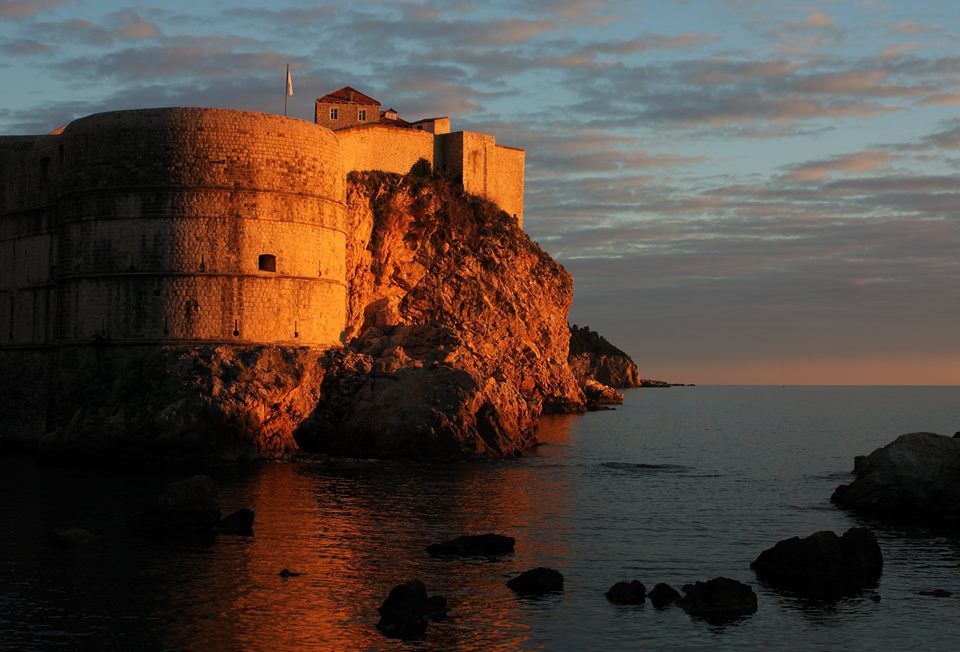
TZ Dubrovnik
This fort was important for defending the city. The gate and the bridge, as well as the moat are located at Pile. The semi-circular tower was designed by Florentine architect Michelozzi in the fifteenth century.
Lovrijenac
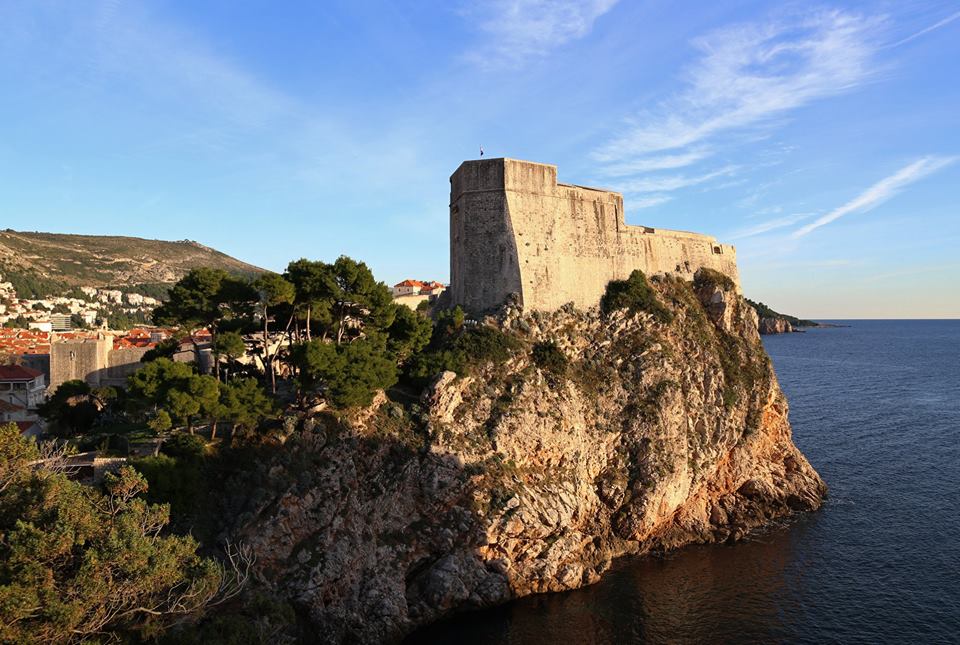
TZ Dubrovnik
This fort is set on the 37-metre-high cliffs outside of the city walls. You can reach it by walking along Pile bay and climbing the steep, stone stairs. This fort was built to protect the entrance to the city from the west. The fort's construction began in 1018 and it was completed in the sixteenth century. The walls are 4 to 12 metres thick. The entrance door boasts the Latin inscription: Non bene pro toto libertas venditur auro (Freedom is not sold for all the gold in the world). There lies the chapel of St. Lawrence and its courtyard where occasional performances and plays are held today.
Revelin Fort

LBM1948
Revelin fort was built outside of the city walls and it was once part of the defence complex of Ploče Gate. The lower part of the fort was built in 1463, and was then rebuilt in 1538. The fort protected the eastern part of the city and the entrance to the city harbour. It has three entrances and is surrounded by a moat and the sea on three sides. Ivan Rabljanin kept the foundries for casting cannons and bells in the large interior. Now it is used as a place for Dubrovnik summer festival plays.
Pile Gate

Pixabay
Just outside the city walls lies Pile – here, you first have the seaside promenade constructed outside of the walls. Here you enjoy an amazing view of the city walls and of Lovrijenac fort. If you enter the city through Pile Gate, the first thing you will see is the stone statue of St. Blaise. There is a stone bridge and a wooden bridge which lead to the outer gate, then to the renaissance semi-circular tower. When you pass through the inner gate, you enter Dubrovnik's main street – Placa or Stradun.
Stradun

TZ Dubrovnik
Placa or Stradun is the main street in Dubrovnik. Stradun is 298 metres long and the statute of the city from 1272 determined the final plan for the city and its main street. The houses on Stradun are built in baroque-style architecture with shops on the street level. Stradun has its modern-day shape after the earthquake in 1667, when a large number of gothic and renaissance palaces were sadly destroyed. Even today, Stradun is the main centre for all the events in the town.
Large Onofrio's Fountain
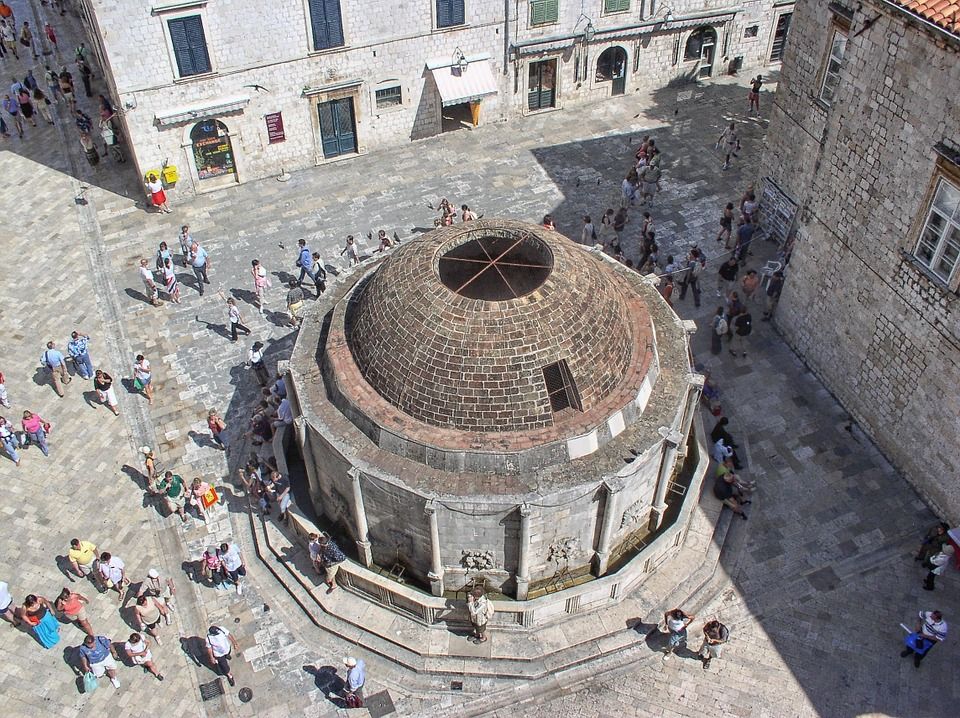
Pixabay
When on Stradun, one of the main sights is the large Onofrio's fountain. This is a large polygonal fountain with sixteen stone carved maskerons which provide running water. The fountain was designed by Onofrio Della Cava who also designed the small fountain at the other end of Stradun – the fountains were built for public use in 1438 when fresh water was brought to the city from Rijeka Dubrovačka. The fountain is now connected to the new waterworks system. The cupola was damaged during the 1667 earthquake and later reconstructions sadly failed to restore it.
Small Onofrio's Fountain
Sailko
Small Onofrio's fountain was designed in 1446 and the stone mason work was handled by Pietro di Martino di Milan. Located in a niche to the city guard building, it is part of the original setting for the carnival play “The tale of Stanac” by the famous Dubrovnik playwriter Marin Držić.
City Guard Building
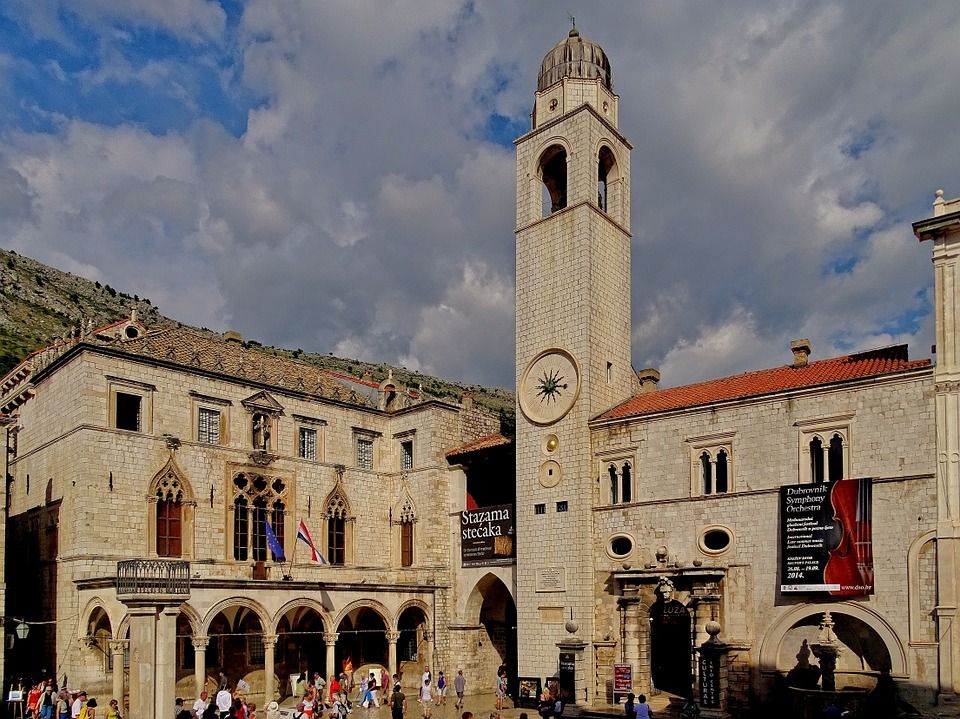
Pixabay
The City Guard building was the admiral’s residence during the fifteeth century. It was restored in the twentieth century and it is now the entrance to the cinema.
Rector's Palace

Pixabay
The Rector's Palace is one of the most important pieces of heritage on the Croatian coast – this was the administrative centre of the Dubrovnik Republic – it is built in a gothic style with reconstructions in renaissance and baroque style. It was damaged in the fifteenth century by gunpowder explosions and restored by Onofrio Della Cava in late gothic style in 1435. The second gunpowder explosion in 1463 destroyed the western facade
and the two famous architects Juraj Dalmatinac and Michelozzo worked on reconstruction. After the earthquake, the atrium was partially reconstructed with a baroque staircase. During his one month mandate, the rector lived in the palace which was the place of both the minor and major council hall, the rector’s residence, the city's courtroom, the administration office(s), the prison, and even for arsenal and gunpowder storage.
Above the entrance door lies the inscription: Obliti privatoru publica curate (Forget your private business, concern yourselves with public affairs).
In the atrium sits the bust of a rich sea captain and benefactor, Miho Pracat, this work was done by P. Giacommetti in 1628. The Miho Pracat statue is the only statue in the city for the common people – The former Dubrovnik Senate decided to do this 1638. The bust is placed between two columns in the eastern wing of the Rector's palace atrium. He was not only a rich seaman who left his wealth to the Republic, but a ship owner and a very skilled merchant. This was an enormous honour as the Dubrovnik Republic never built statues for its contemporaries, and found it inappropriate to have statues in public places. Today, the Rector's Palace is the home of the Dubrovnik museum.
Ploče Gate
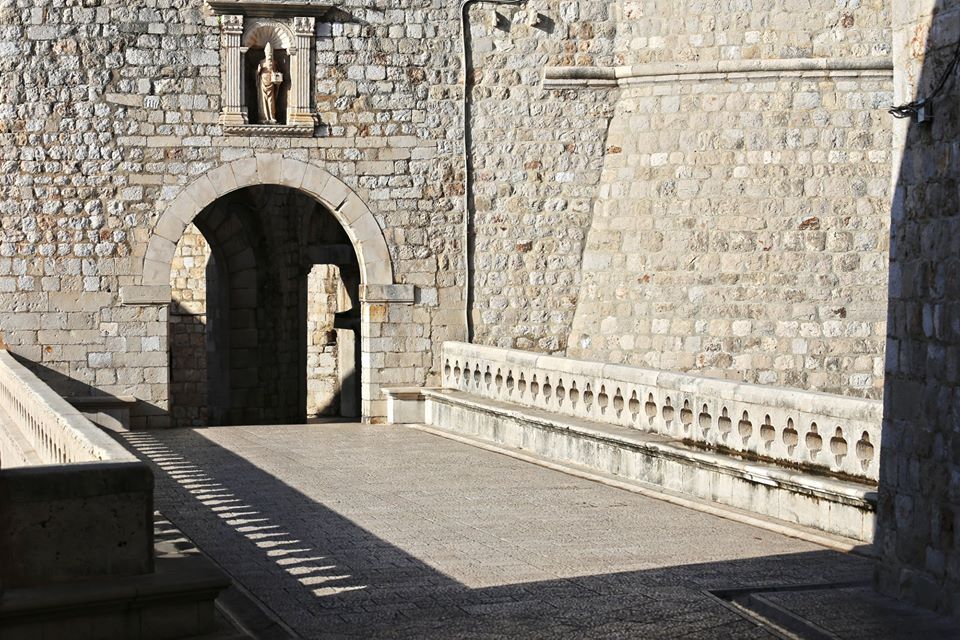
TZ Dubrovnik
Ploče gate is the eastern entrance to the city. When you pass through this gate, you will see two small churches. This entrance is fortified and had inner and outer gates with stone bridges from the fifteenth century onwards, and there lies a statue of St. Blaise, the city's patron saint.
Luža and the City Bell Tower

Pixabay
After passing through Ploče gate, you will end up in front of Luža and the City Bell Tower. The bell tower, built in 1444, once had figures called Zelenci who struck each hour with their hammer. The bell tower was damaged in the earthquake and it was rebuilt in 1929, while the Zelenci figures were replaced with replicas.
Sponza Palace
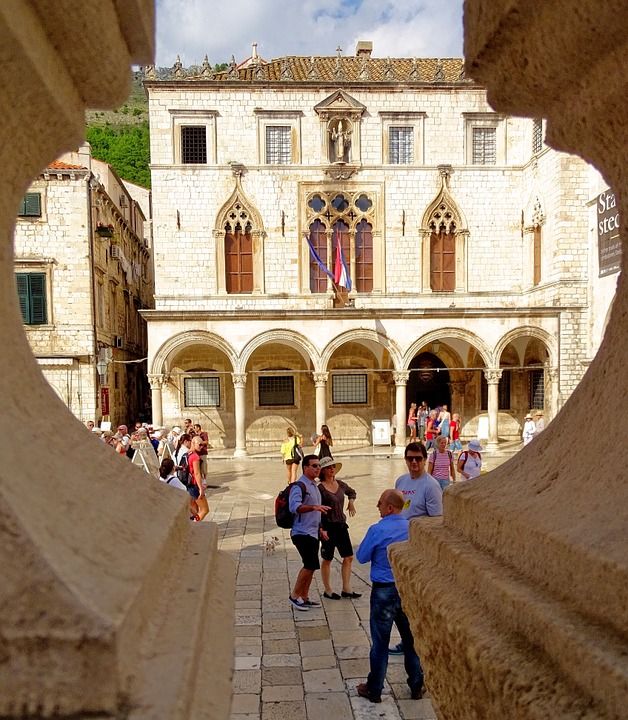
Pixabay
Right next to the bell tower lies Sponza Palace. This building is the best example of Dubrovnik's highly specific gothic-renaissance style. It was constructed in the sixteenth century based on the design of Paskoje Miličević. It was built in a rectangular shape and has a portico and an atrium. On the main wall lies the inscription: Fallere nostravetant, et fall pondere, meqve pondero cvm merces ponderat ipse deus (We are forbidden to cheat or falsify measures and when I weigh goods, God himself is weighing them with me).
This was the liveliest commercial centre of the city and in the seventeenth century, it became the meeting point for members of the Academy who discussed literature, the arts, and science. Today, it’s the home of the Dubrovnik archives.
Church of St Blaise
TZ Dubrovnik
The Church of St. Blaise is one of the most important buildings in Dubrovnik. St. Blaise is the patron saint of Dubrovnik who has been celebrated every year on February the 3rd, and this festivity is part of the city's UNESCO intangible heritage. The church got its present form is from 1715 and is a shining example of Venetian Baroque. It was built by Marino Gropelli upon the request of the Dubrovnik Senate. It was damaged in the earthquake, and then again in the fire in 1706.
In that fire, everything was destroyed except the silver statue of St. Blaise. This statue was then kept in the small church of St Nicholas on Prijeko before being brought back to its original place in 1715. This statue is one of the most valuable sculptures in Dubrovnik and the saint holds the city model, from which one can see how Dubrovnik once looked long ago. St Blaise has been being celebrated in Dubrovnik from the tenth century onwards, when he saved the people of Dubrovnik from a surprise Venetian attack with a solemn warning.
Orlando’s Column
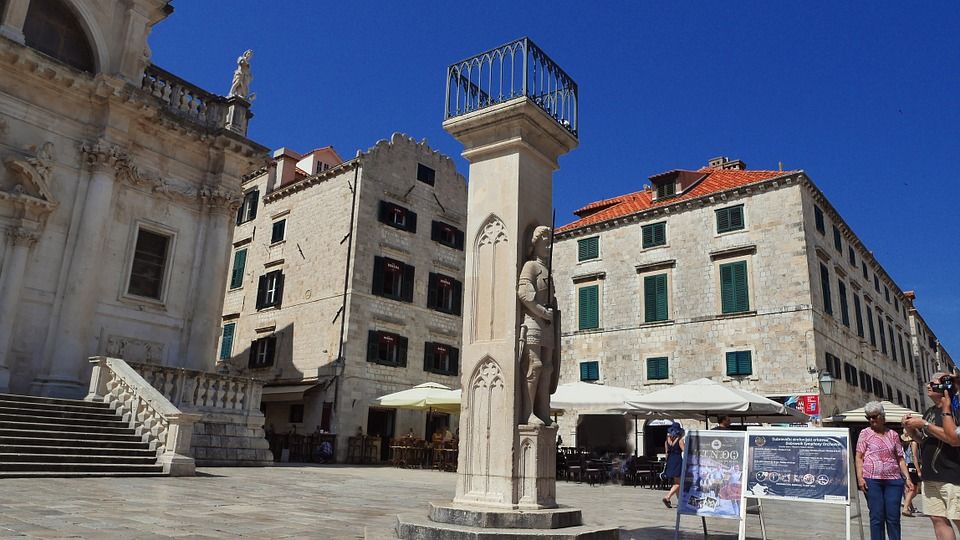
Pixabay
In front of the Church of St. Blaise lies the most important symbol of statehood and freedom for Dubrovnik – Orlando’s column. Orlando’s column was constructed by Bonino di Jakopo and Antun Raguso. Erected in 1419, Orlando’s column, with the statue of a medieval knight, stands in the square and presents Roland, the eighth-century knight from the Chanson de Roland. The reason this statue is in Dubrovnik is probably because it was brought by King Sigismund, a Hungarian and Bohemian king who was the patron of Dubrovnik Republic.
Additionally, there is a legend that says Roland saved Dubrovnik from Saracens and defeated them near the island of Lokrum. Senate decisions were announced in front of it. This statue was also a punishment spot and a pillar of shame. The white flag of the Dubrovnik Republic with the image of St. Blaise remained on the column until the abolition of the Republic in 1808. Now the Croatian flag flies there, and the flag is changed only during the Festivity of St. Blaise and during the Dubrovnik summer festival. This year, Dubrovnik is marking the 600th anniversary of the construction of Orlando’s column, and therefore 2019 is considered to be the year of Orlando.
Buža Gate
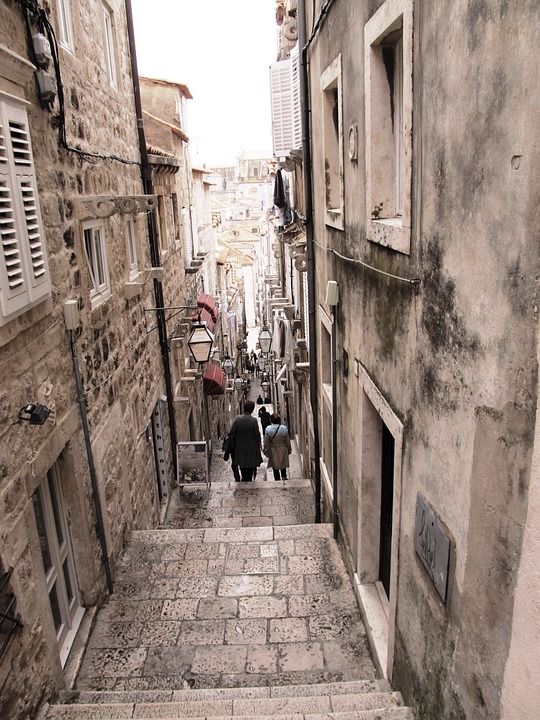
From Prijeko to Ruđer Bošković street (the place where the famed eighteenth century Croatian scientist, physicist, astronomer, and poet was born) stands the gate that was built back in 1907.
Gundulić Square
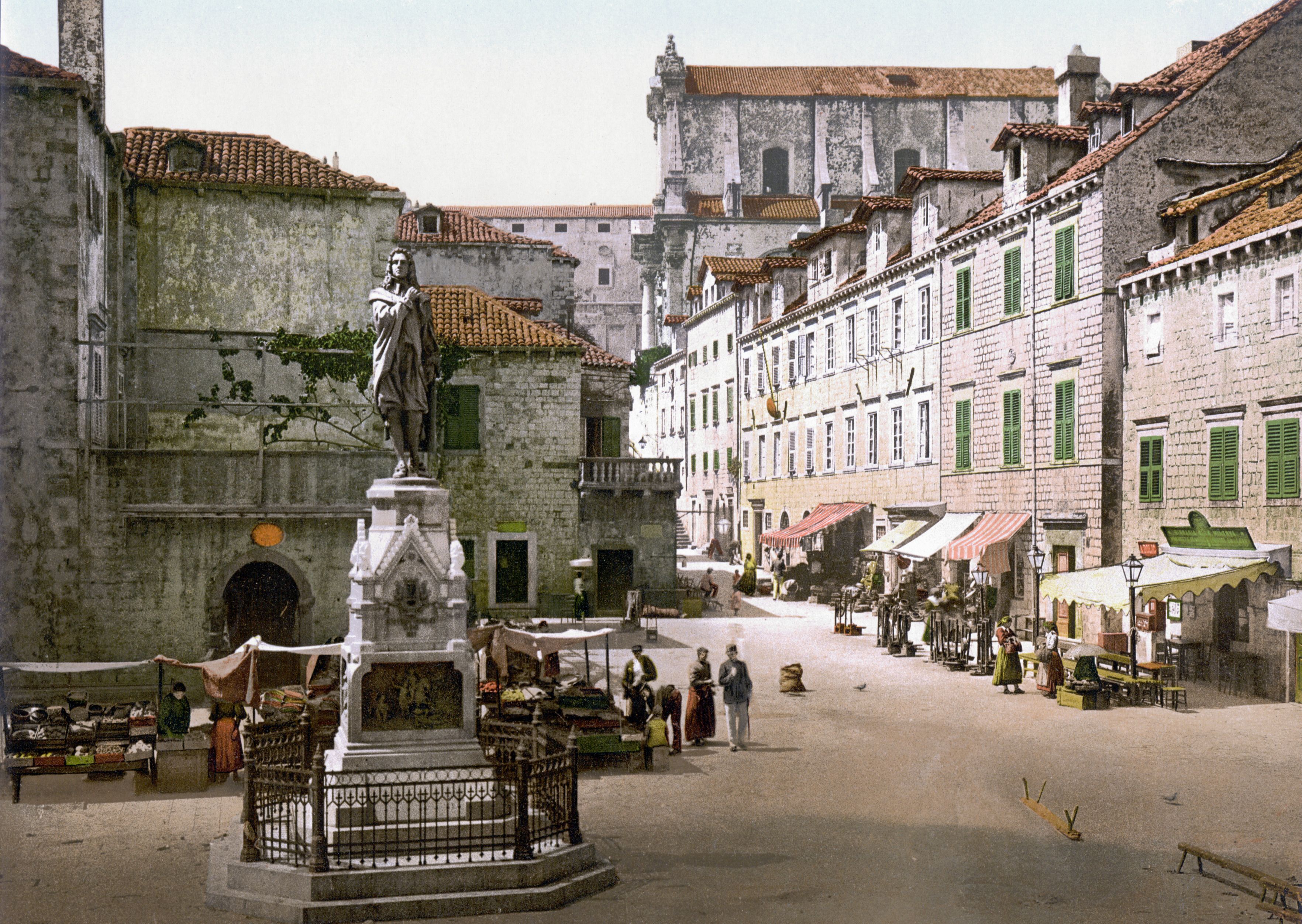
Behind the cathedral lies Gundulić square which is home to the statue of Ivan Gundulić, one of Dubrovnik's best eighteenth-century poets – this statue is the work of Ivan Rendić, and on the base of the statue there are bronze relives with scenes from Gundulić's epic poem - Osman. Ivan Gundulić was born in 1589 to an old and respectable aristocrat family. He later became famous on his own merit for his valuable works. This is the place where the green market in the morning sets up. What is interesting is that in front of the statue there are hundreds of pigeons waiting for their meal every single day – the city funds ten kilos of corn to feed the pigeons.
Jesuit Church

Pixabay
From there, if you go up the baroque stairs you will reach the Church of St. Ignatius or Jesuit church which is the home of Dubrovnik's most beautiful baroque complex. This church is the work of Ignazio Pozzo and right next to it is Collegium Ragusinum, the famous Jesuit school. Collegium Ragusinum was initially founded because the people of Dubrovnik were dissatisfied with their Italian teachers. The first steps for this to happen were initiated in the sixteenth century but it wasn't until the end of seventeenth and the beginning of the eighteenth century that works started. Collegium Ragusinum hosts a massive 10,000 volumes with incunabula and manuscripts by Dubrovnik's numerous writers.
City Harbour
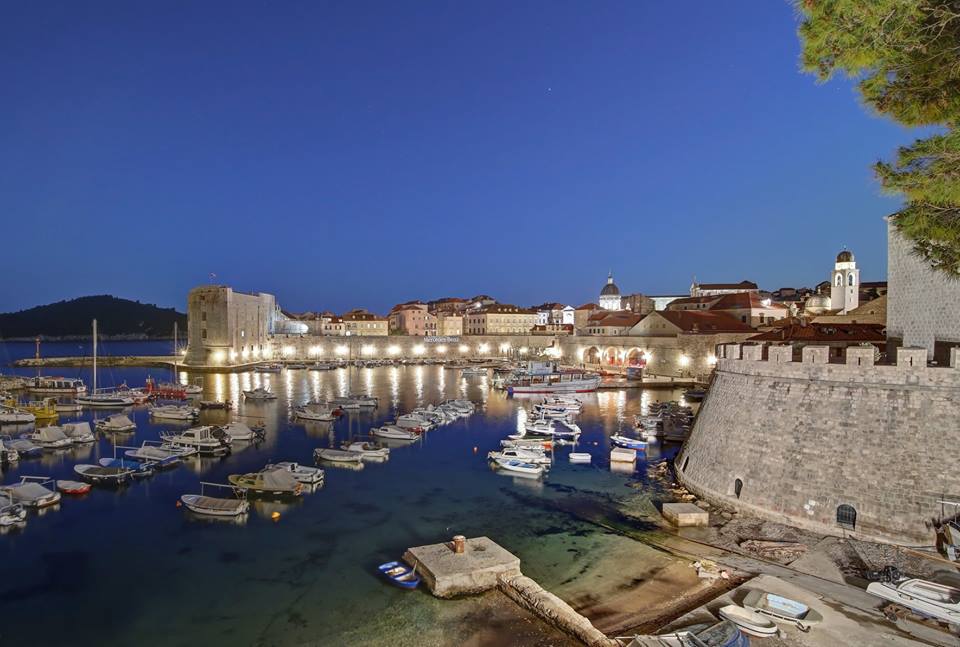
TZ Dubrovnik
The city harbour got its look back in the fifteenth century - the most recognisable part of it is the three arches of the large arsenal. East from the large arsenal there is the fish market gate and then three arches of small
arsenals where smaller ships were repaired. At the location of the large arsenal today lie the city cafe and the theatre.
Lazarettos
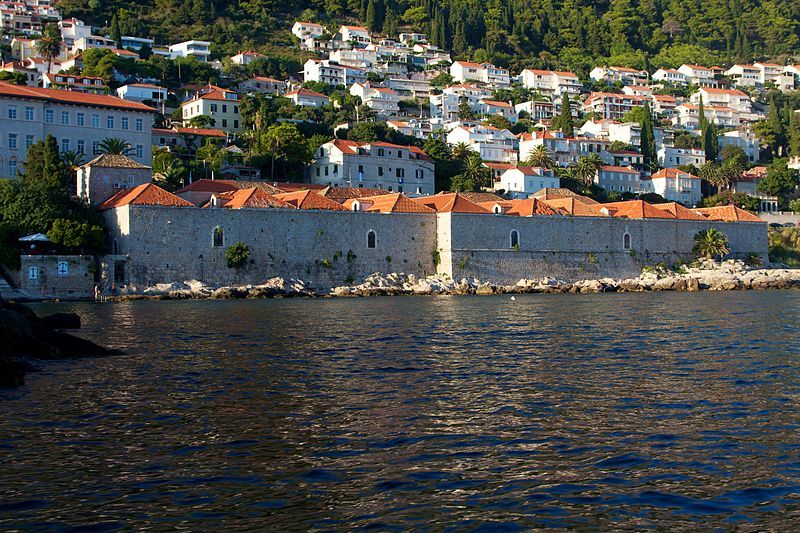
Ramon
Lazarettos (Lazaretti)
This was the place for the first quarantine built in the fourteenth century in order to isolate travellers and goods from eastern countries. There were eight buildings and five courtyards which were renovated in the sixteenth century. This complex included large warehouses and lodging for the extended stay of merchants and travellers. In the seventeenth century, this was the largest merchant transit centre on the Adriatic and one of
the best-organised quarantines in the entire Mediterranean.
With this sheer amount of invaluable heritage that is still standing today after all these centuries, Dubrovnik definitely deserves to be considered one of the greatest towns in the world, and its popularity in terms of tourist visits and global interest is very much understandable.
Winter Wonderland at Plitvice Lakes
December 4, 2018 - Designated a UNESCO World Heritage site since 1979, the Plitvice Lakes are Croatia's biggest, oldest and most visited national park.
Hundreds of thousands of people visit the Plitvice Lakes each year, and the vast majority flocks to the park during summer. Now I'm not saying there's anything wrong with that – au contraire! – it is an amazing place to visit during all four seasons. However, if you happen to be nearby sometime between January and March, you definitely don't want to miss out on winter wonderland at Plitvice.
The best part of visiting Croatia's most frequented national park during wintertime is, obviously, very few visitors and no crowds. No waiting in lines at the ticket counter. No slow-walkers ahead of you, and no one breathing down your neck. And just imagine having the park nearly all to yourself? Such bliss!
Then there's the magnificent winter scenery: landscapes blanketed by freshly fallen snow, flaunting the frigid beauty of winter. Because spring, summer, and fall are beautiful and all... but Plitvice under the snow? So silent and serene – truly a sight to behold.
And let's not forget the diverse wildlife, as the Plitvice lakes are home to bears, wolves, lynxes, otters and other lake dwelling creatures, numerous rare bird species, etc. Okay, to be honest, I didn't really see that much of Plitvice's feathered and furry residents, but I saw some ducks, and they were pretty (and) wild.
If you're still not quite convinced, please enjoy the Outdoors Croatia video below, and for more related content, make sure you follow our dedicated travel page.
UNESCO Intangible Heritage of Croatia – The Art of Dry Stone Walling
December the 1st, 2018 - Dry stone walling can be seen all along the Adriatic coast as well as in the Dalmatian hinterland and beyond. Now inscribed onto UNESCO's list, let's take a deeper look into this piece of the intangible heritage of Croatia.
On November the 28th, 2018, UNESCO inscribed two more pieces of intangible heritage from Croatia made UNESCO's prestigious list. The first one was Medjimurska popevka, a type of traditional singing, and the second was the art of dry stone walling.
This article will look into the art of dry stone walling and the traditions related to it. This piece of heritage is already on the list of the intangible heritage of Croatia, and in 2015 and 2016 an international effort to nominate this heritage for the UNESCO Representative list of the Intangible Cultural Heritage of Humanity was made. The main coordinators for the nomination from Croatia were the Ministry of Culture and the 4 Grada Dragodid association.
.jpg)
Dry walling is the construction of a stone wall by stacking stones upon each other without the use of any connection material like cement, except sometimes dry soil. The stone used is usually not processed. Its product is “suhozid” or dry wall (other names for it depending on the region are gromača, međa, mocira, mocir, masiera, redina, prizida, zid, mrtvi zid, mrtvi mir etc) which can be often found along entire Adriatic coast as well as in the Dalmatian inland area.
Another characteristic product of this way of this type of building are smaller objects made completely of dry stone, which were used for different purposes. The stability of the dry stone structures is ensured by selecting and properly placing the stones. These dry stone structures are an example of a type of construction which lives in harmony with nature and this inscription aims to preserve the know-how of building it. The practice is usually passed down with practical application adapted to the specific conditions of different areas in which it is typically made.
.jpg)
Dry stone walls are spread along the Adriatic coast, as well as inland, and the walls created via this technique resist the test of time. Their self-preservation is good example on how we can learn more and cherish such a sustainable way of building. There are different types of construction – from dry stone walls around houses, gardens, vineyards to shelter buildings or even actual houses and their elements. These buildings can act as the inspiration for a new period of dry stone construction, and the people still building in this manner could be a valuable source of information.
.jpg)
One incredible example of preserved dry stone walls is Croatia's very own ''fingerprint island'' – Baljenac, with 23,35 km of dry stone walls on the island. The organisation 4 Grada Dragodid, whose website is filled with information about this piece of heritage was founded in 2007, but its very first beginnings are from 2002. Back then, the first international dry stone workshop in the village of Dragodid, close to Komiža on Vis, was held.
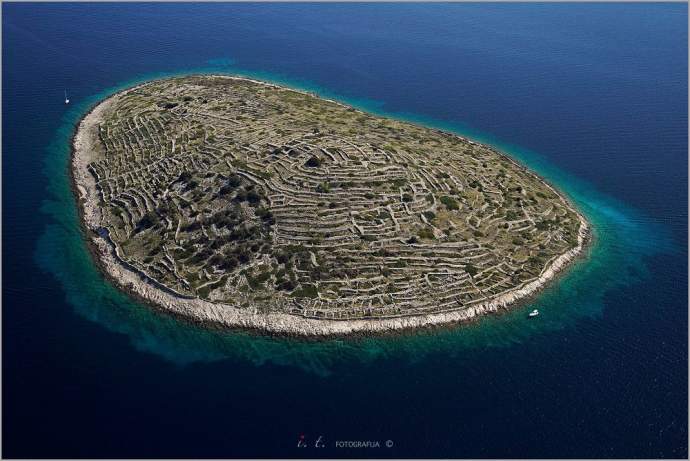
The main activities of the Dragodid association include organising and managing dry stone workshops, and researching dry stone heritage with local partners and those who still use this method of construction in the modern day. Another international organisation was founded recently and its goal is to form a cultural route of European dry stone heritage as part of the wider cultural routes programme.
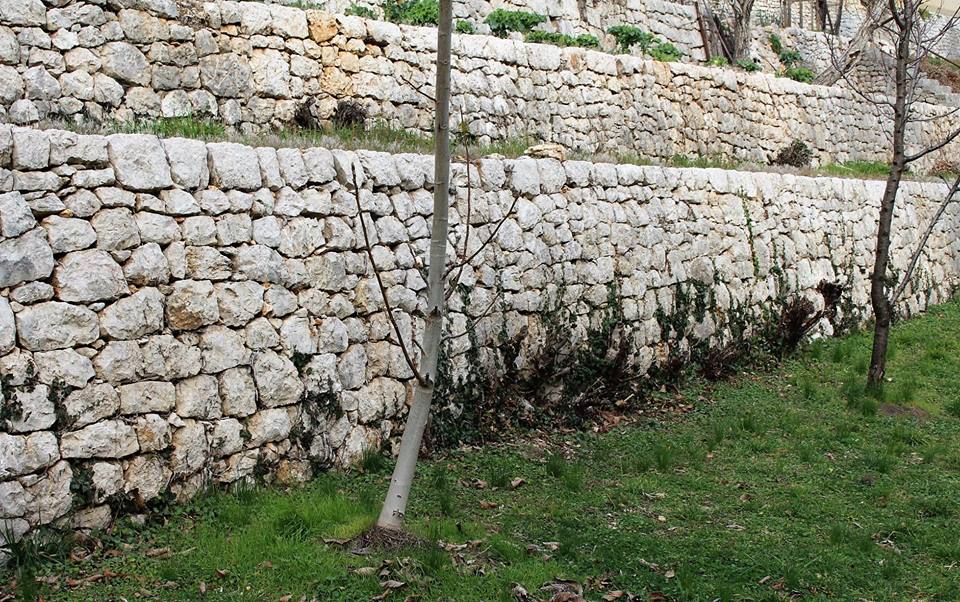
There is even a website, which is the open public inventory of the Croatian dry stone heritage where anyone can add a contribution in order to broaden public knowledge on dry stone wall construction and its distribution along the Adriatic coast and in the hinterland.
A contribution can be added by sending in a photo and all the available information on the dry stone building, structure or ambient, accompanied by the accurate location information. They even have a mobile app which makes the whole process even easier. With activities like this and the welcome recent UNESCO recognition, dry stone walling heritage will definitely remain an essential part of local traditions and the intangible heritage of Croatia.
SOURCE(S) (text and photos): UNESCO, Ministry of Culture, Dragodid, Suhozid.hr, Total Croatia News, Jagul Wine Cellar
Make sure to follow our dedicated lifestyle page for more information on the intangible heritage of Croatia and much more.
UNESCO Intangible Heritage of Croatia – Međimurska Popevka
December the 1st, 2018 - With two more pieces of Croatia's rich heritage having been added to the prestigious list, we take a look at one piece of UNESCO intangible heritage of Croatia, a musical tradition originating from Medjimurje - Medjimurska popevka.
On November the 28th, 2018, UNESCO inscribed two more pieces of intangible heritage from Croatia onto its list. The first one was Medjimurska popevka, which is a form of traditional singing from the continental county of Medjimurje. The second was the art of dry stone walling, the knowledge and techniques of which were inscribed together with Cyprus, France, Greece, Italy, Slovenia, Spain, and Switzerland.
This article will look into Medjimurska popevka, traditional folksong, and its heritage. This piece of heritage was arlready on the list of the intangible heritage of the Republic of Croatia, and as of now, it is also part of the UNESCO Representative List of the Intangible Cultural Heritage of Humanity.
.jpg)
The nomination process started back in 2016 and was prepared with the following experts: dr. sc. Lidija Bajuk, dr. sc. Nail Ceribašić and dr. sc. Tvrtko Zebec, along with the support of the local community and institutions from Medjimurje County.
Medjimurska popevka is an irreplaceable part of the area's local traditions and is a very popular and recognisable form of singing. This singing originates from the north-western part of Croatia and is historically a soloist vocal genre sung by women. Medjimurska popevka is used in vocal, vocal-instrumental, instrumental, monophonic and multipart renditions as a musical genre or incorporated into the dance.
Popevka has verses which are sung according to melody (viža) and in that way, they form a song (pesem). The songs are divided into the category of newer and older songs and when it comes to lyrics they are usually related to love, sad melancholy, humor and other types of emotion experienced in varying life events.
.jpg)
In general, most of the people from Medjimurje have experienced popevkas in numerous life events and were encouraged to join the making of the music in these situations. This makes popevka important an part of family and friends’ gatherings in Medjimurje. When we look into the history of this traditional singing, we can find the oldest textual evidence of popevkas dating back to the 16th century.
The songs were initially sung without any musical instruments until the 19th century, and then from then, it became common to use instruments too. Even though the songs are divided into older and newer categories, they still have the traditional way of singing and similar lyrics and themes.
.jpg)
The older songs usually involve mythological themes and are sung in a natural scale, while the newer songs are generally about real events and people, and have balanced metrical structure. The most active representatives who keep this piece of heritage alive and kicking are the cultural artistic societies and associations, as well as individual singers. At the moment, there are fifty singers regarded as masters of the art, and they are considered to be the ones able to teach these singing techniques to younger generations.
There are various cultural associations and folklore groups who use Medjimurska popevka in their performances. One of the events important for keeping this piece of heritage active is Smotra međimurske popevke, which has been happening every year since 1971 in Nedelišće.
.jpg)
Last year in June, the 38th consecutive festival of Medjimurska popevka with many participating folklore groups took place. In this way, the singing is shared among the wider public and still kept within the local community as an important part of life. Now inscribed on the list of UNESCO's intangible heritage of Croatia, this cultural gem will continue to have its significance highlighted and protected.
SOURCE(S) (text and photos): UNESCO, Ministry of Culture, Muzej Međimurja Čakovec, Culturenet, HRTurizam, Tourist Board Nedelišće
Make sure to follow our lifestyle page for more information on the UNESCO intangible heritage of Croatia and much more.


